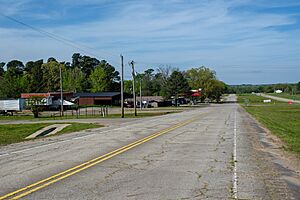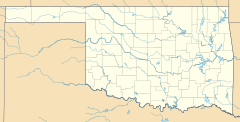Eagletown, Oklahoma facts for kids
Quick facts for kids
Eagletown
Ossi Tamaha (Choctaw)
|
|
|---|---|
 |
|
| Country | United States |
| State | Oklahoma |
| County | McCurtain |
| Area | |
| • Total | 4.74 sq mi (12.28 km2) |
| • Land | 4.73 sq mi (12.26 km2) |
| • Water | 0.01 sq mi (0.02 km2) |
| Elevation | 427 ft (130 m) |
| Population
(2020)
|
|
| • Total | 404 |
| • Density | 85.36/sq mi (32.96/km2) |
| Time zone | UTC-6 (Central (CST)) |
| • Summer (DST) | UTC-5 (CDT) |
| FIPS code | 40-22350 |
| GNIS feature ID | 2629916 |
Eagletown is a small community in McCurtain County, Oklahoma, United States. It is not an official city but a "census-designated place" (CDP), which means it's a special area for collecting population data. In 2020, about 404 people lived there.
Eagletown is located near the Mountain Fork River, about 6 miles (9.7 km) from the border of Oklahoma and Arkansas. It was the very first permanent home for the Choctaw people when they moved to the Indian Territory. They called it o̱ssi tamaha, which means "Eagle." Eagletown was a very important town from 1834 to 1906. After 1850, it became the main town for the Choctaw Nation's Eagle County. The town's name was officially changed to "Eagle Town" in 1850, and then to "Eagletown" in 1892. When Oklahoma became a state in 1906, Eagletown lost its special status and became a regular community in the new McCurtain County.
Contents
History of Eagletown
Early Settlers and the Choctaw Nation
Before the Choctaw people arrived, some white settlers lived near the Mountain Fork River in the early 1800s. This area was then part of Miller County, Arkansas. But in the 1820s, the borders changed, and this land became part of the Indian Territory. The white settlers had to move so the Choctaw tribe could resettle there.
When the first Choctaws arrived in 1832, they found clear fields for farming and cabins that had been left behind. The Army set up a place here to give out food and supplies, as promised in a treaty. In April 1832, about 852 people were getting supplies here. By 1834, the number of people in Eagletown had grown to 1,500.
Missionaries and Education
The Choctaws invited some white missionaries to join them in the Indian Territory. One of the first was Reverend Loring S. Williams, who arrived in 1832. He started a place called Bethabara on the west side of the Mountain Fork River. A very old cypress tree, known as "the oldest tree in Oklahoma," marked the river crossing.
In 1834, Williams started the first church in Choctaw country and opened a school the next year. He also helped set up a post office in 1834 and was its first postmaster. The post office and the town were known as "Eagle Town." The name officially changed to "Eagletown" on December 16, 1892.
Another missionary, Reverend Cyrus Byington, arrived in late 1835. He stayed for 31 years and was famous for creating a written Choctaw language. He translated many religious and everyday materials into Choctaw. Byington started the Stockbridge Mission on the east side of the river, across from Bethabara. He is best known for writing the Dictionary of the Choctaw Language. Byington also oversaw the Iyanubbi Female Seminary, a boarding school for Choctaw girls that operated from 1844 to 1861.
Eagletown as a Trading Center
Eagletown quickly became an important trading spot on the Military Trace. This was a wagon trail built in the 1820s to connect Fort Towson with other military forts in Arkansas.
After the Choctaw Nation wrote its own constitution in 1850, Eagletown became the "courtground," or main town, for the new Eagle County. Jefferson Gardner, a Choctaw trader, opened a general store on the east bank of the river in 1874. In 1884, he built a large house that is now listed on the National Register of Historic Places (NRHP). Gardner later became the main leader of the Choctaw Nation.
Changes After Oklahoma Became a State
When Oklahoma became a state, more white settlers moved into the area that was once Choctaw territory. Eagle County was replaced by McCurtain County. Some new settlers became farmers, while others worked in the growing timber industry.
The Choctaw Lumber Company (later called Dierks Forests) built a camp in Eagletown for timber workers. The company also built a railway, the Texas, Oklahoma and Eastern Railroad, which connected to its lines in Arkansas.
In 1920, the Texas, Oklahoma and Eastern Railroad built a track from Valliant, Oklahoma to DeQueen, Arkansas. They built a train station about 2.5 miles (4.0 km) southeast of the river crossing. Many businesses from the old Eagle Town moved to new buildings near this new station. Today, not much is left of the old Eagle Town, except for the historic Gardner house.
Population Information
| Historical population | |||
|---|---|---|---|
| Census | Pop. | %± | |
| 2020 | 404 | — | |
| U.S. Decennial Census | |||
Notable Person
- Cyrus Byington - An American missionary who helped the Choctaw people.
See also
 In Spanish: Eagletown (Oklahoma) para niños
In Spanish: Eagletown (Oklahoma) para niños



